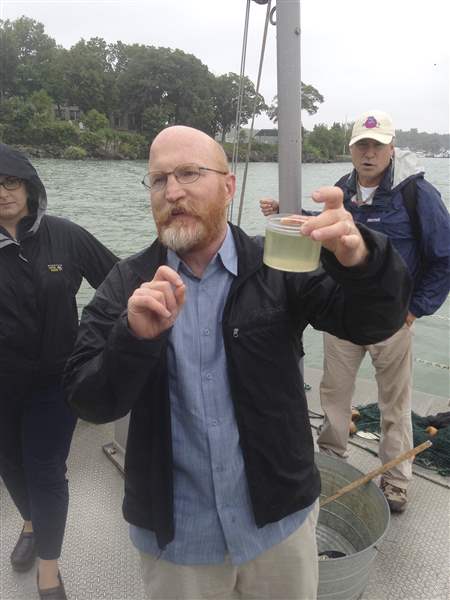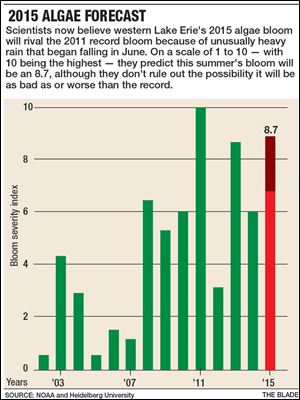
SUMMER FORECAST REVISED
Lake algae levels could rival 2011 record bloom
Heavy rains increasing nutrients
7/10/2015
University of Toledo algae researcher Tom Bridgeman examines a microcystis sample from Lake Erie.
THE BLADE/TOM HENRY
Buy This Image

University of Toledo algae researcher Tom Bridgeman examines a microcystis sample from Lake Erie.
GIBRALTAR ISLAND, Ohio — Scientists say heavy rains this season have taken a toll and Western Lake Erie’s 2015 algae bloom will rival the 2011 record for total biomass.
Rick Stumpf, a National Oceanic and Atmospheric oceanographer from Maryland who heads up western Lake Erie’s algae-forecasting program, said heavy rain has made the lake so nutrient-rich in recent weeks there’s no going back.
“The nutrient load is so large now that adding more [nutrients] isn’t going to make that much of a difference,” Mr. Stumpf said. “The damage is done.”
He said there is a possibility the density and acreage covered by this summer’s algal bloom could equal or surpass the 2011 record bloom, but said the emerging science of predicting algal blooms isn’t sophisticated enough to predict the odds of that happening.
The forecasting system began after the 2011 bloom.
Western Lake Erie has become a research model to test it out before deploying it on other large bodies of water across the country.
Mr. Stumpf’s comments and those of numerous other scientists and public officials were made Thursday at two locations, first at Ohio State University’s Aquatic Visitors Center on South Bass Island, then at OSU’s Stone Laboratory on nearby Gibraltar Island.
The day’s events were supposed to be held on the latter, but high water and heavy rain prompted organizers to make a last-minute switch and have the morning session on South Bass Island.
“The forecast is definitely worse than 2014,” Mr. Stumpf said. “Right now, we’re looking at the second worst bloom after 2011.”
The severity is considerably worse than early predictions from May, when an average bloom was anticipated, and even worse than the latest update a couple of weeks ago.
NOAA rates this year’s expected bloom as an 8.7 on a scale of 10, with 10 being the 2011 record. The 2014 bloom’s severity was rated as 6. That, scientists said, is an important point because the size of a bloom is only one risk indicator.
The algae-induced Toledo water crisis of 2014, when nearly 500,000 metro water customers scrambled for bottled water when their tap water was deemed unsafe the first weekend of August, came at the beginning of that year’s algae season.
But there was a perfect storm of wind, weather, and atmospheric conditions that pushed a highly toxic bloom deeper underwater than it normally goes. It got sucked into Toledo’s water-intake crib and into the city’s Collins Park Water Treatment Plant.
Large algal blooms don’t necessarily equate to bigger risk, scientists said, because all blooms are equally as toxic. The blooms have been occurring almost annually since 1995, rarely getting deep enough below the surface to get sucked into water plants.

Toledo has stockpiled four times the amount of potassium permanganate, chlorine, and powdered carbon as the city used last year to help remove the chief toxin, microcystin.
Raw lake water drawn in through the intake crib is treated with potassium permanganate and chlorine for hours en route to the city’s low-service pump station on the shoreline.
Then, it gets more treatment en route to the water plant, where particles are bound together so they can settle out of the water. The full treatment process at the plant includes passing the cleaned water through a series of filters and holding it in an underground reservoir for seven hours to disinfect it and remove viruses.
Computerized buoys and sensors have been deployed in the lake to give plant operators more time to make adjustments.
The city also is in the midst of spending $300 million to expand and improve the treatment process. That work is expected to be completed in 2019, with other long-term improvements being considered.
Huge mats hurt Lake Erie’s recreation and tourism industries even if they don’t affect drinking water, officials said.
Ohio Sen. Randy Gardner (R., Bowling Green) said the Toledo water crisis made combating algae much more of a bipartisan effort than it was in years past.
“It’s kind of fashionable to want to get things done about Lake Erie now,” Mr. Gardner said. “We’ve made some real strides in a bipartisan way.”
Laura Johnson, research scientist at Heidelberg University’s National Center for Water Quality Research, said this June’s runoff into the Maumee River was the most for any June at the river’s Waterville station since Heidelberg began collecting data there in 1974.
The Waterville station is one of 18 monitored by Heidelberg and has generated more runoff data than any other site in the Great Lakes region.
Contact Tom Henry at: thenry@theblade.com, 419-724-6079, or via Twitter @ecowriterohio.